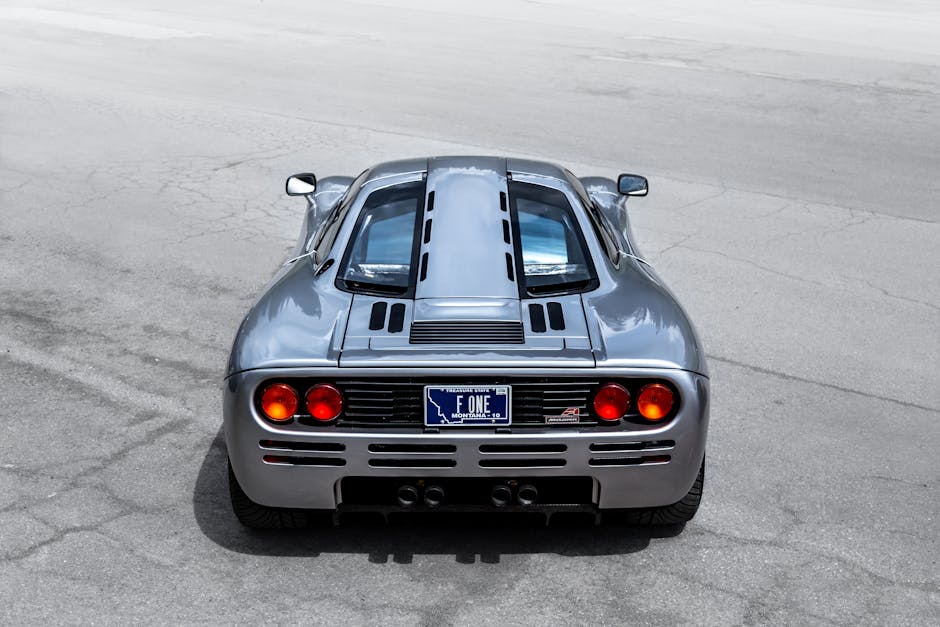Hybrid Supercar Technology: 7 Powerful Reasons They Matter 2025
The Revolution of Performance: How Hybrid Supercar Technology Works
Hybrid supercar technology combines traditional internal combustion engines with electric motors to deliver unprecedented performance while reducing emissions. For sports car enthusiasts wanting to understand this technology quickly:
| Key Aspect | What You Need to Know |
|---|---|
| Basic Concept | High-performance gasoline engine + electric motor(s) working together |
| Performance Boost | Electric motors provide instant torque to fill gaps in combustion engine power delivery |
| Key Benefit | Faster acceleration, better handling, and improved efficiency |
| Common Types | Plug-in hybrids (larger batteries, can charge externally) and mild hybrids (smaller systems, self-charging) |
| Real-World Numbers | Up to 1,000+ horsepower in models like the Lamborghini Revuelto (1,001 hp) |
The automotive world is witnessing a change that would have seemed impossible just a decade ago. The roaring V12 engines that once defined supercar excellence are now being complemented—and in some cases outperformed—by whisper-quiet electric motors.
When McLaren, Ferrari, and Porsche unveiled their “Holy Trinity” of hybrid hypercars in the early 2010s, many purists feared electrification would dilute the supercar experience. They couldn’t have been more wrong.
“Electric motors provide instant torque and controllability that gas engines alone can’t match without higher emissions,” explains a leading industry expert. This instant-on power delivery has revolutionized performance, with hybrid supercars now routinely outperforming their pure-gasoline counterparts.
Modern hybrid supercars like the Ferrari 296 GTB, McLaren Artura, and Lamborghini Revuelto don’t just match traditional supercars—they redefine what’s possible. The Corvette E-Ray, America’s first electrified supercar, hits 60 mph in just 2.5 seconds—faster than many exotic cars costing three times as much.

Essential hybrid supercar technology terms:
– automotive technology expo
– auto tech seminars
Inside Hybrid Supercar Technology: Anatomy of the Powertrain
When you peek beneath the sculpted bodywork of today’s hybrid supercars, you’ll find a marvel of engineering that makes traditional powertrains look almost primitive by comparison. These aren’t just engines with batteries bolted on—they’re intricate symphonies of mechanical and electrical components working in perfect harmony.
At the heart of hybrid supercar technology sits a new generation of electric motors that are revolutionizing performance. Axial-flux motors, sometimes called “pancake motors” for their flat design, deliver exceptional power density—packing more punch into less space than conventional radial motors. This space efficiency is crucial when every ounce and inch matters in a supercar.
These electric powerhouses are typically mounted in carbon fiber monocoques (or “tubs”)—ultralight structural shells that provide the rigidity needed for precise handling while offsetting some of the weight added by hybrid components. McLaren’s Artura, for example, uses a new Carbon Lightweight Architecture specifically designed to integrate hybrid elements without compromising the car’s agility.

Battery technology in these vehicles isn’t just borrowed from electric cars—it’s purpose-built for performance. While most EVs prioritize range, supercar batteries focus on power delivery and rapid charging/discharging capabilities. They’re also ruthlessly optimized for weight, with sophisticated chemistry and cooling systems that maximize output while minimizing mass.
How Hybrid Supercar Technology Delivers Instant Torque
“The immediacy of electric torque fundamentally changes how these cars feel,” explains one veteran supercar engineer. “There’s no waiting—just instantaneous response that makes even the best combustion engines seem hesitant by comparison.”
This responsiveness comes from torque-vectoring systems that can direct power precisely where it’s needed. In cars like the Porsche 918 Spyder or Lamborghini Revuelto, electric motors on the front axle create all-wheel-drive capabilities that weren’t possible with traditional mechanical systems, improving both traction and handling.
Perhaps the most transformative aspect of hybrid supercar technology is how it eliminates turbo lag. Electric motors provide immediate thrust while turbochargers build boost pressure, creating seamless acceleration that was once impossible. The McLaren Artura’s electric motor fills the torque gaps during gear changes too, maintaining uninterrupted acceleration through shifts.
Hybrid Supercar Technology in Racing
As with most automotive innovations, racing has been both a proving ground and accelerator for hybrid supercar technology. Formula 1’s adoption of hybrid powertrains in 2014 created a direct pipeline for technology transfer to road cars.
Energy Recovery Systems (ERS) developed for F1 have been refined and adapted for production supercars. These systems harvest energy during braking and, in some cases, from exhaust gases, converting what would be wasted heat into usable electric power. The McLaren P1’s system, for instance, shared core principles with the company’s F1 powertrains.
In endurance racing, the IMSA GTP class showcases hybrid technology’s durability and efficiency advantages. Cars like the Porsche 963 and Cadillac V-Series.R combine traditional engines with electric boost to maintain peak performance throughout 24-hour races while managing fuel consumption—challenges directly relevant to road car development.
Some manufacturers are pushing beyond conventional battery systems entirely. Lamborghini has pioneered the use of supercapacitors in its hybrid systems, drawing on scientific research on supercapacitor hybrids to create systems that prioritize rapid power delivery over extended electric range.
Performance, Efficiency & Emotion: Why Hybrids Outrun the Past
The numbers don’t lie – hybrid supercar technology has completely rewritten the performance rulebook. What was once considered impossible is now the new normal:
Ferrari’s SF90 Stradale rockets from 0-60 mph in a breathtaking 2.5 seconds, quicker than any Ferrari that came before it. The Lamborghini Revuelto matches that sprint time while pushing beyond 217 mph at the top end. McLaren’s Artura demolishes the 0-200 km/h dash in just 8.3 seconds. Perhaps most impressively, the Corvette E-Ray – at a fraction of the price – keeps pace with exotics costing three times as much.
These aren’t just incremental improvements – they’re quantum leaps made possible by the perfect marriage of gas and electric power. The instant torque from electric motors, the superior traction of electrified all-wheel drive systems, and the consistent power delivery throughout the rev range create a performance cocktail that traditional engines simply can’t match.

But the hybrid advantage extends far beyond straight-line speed. These systems transform how a car handles through corners too. Electric torque vectoring provides a level of precision that mechanical systems can’t touch, while regenerative braking allows for more nuanced control when slowing down. Remember when the Porsche 918 Spyder shattered the Nürburgring production car record? That wasn’t just raw power at work – it was the intelligent deployment of that power through every inch of the corner.
While efficiency might be a secondary concern for supercar buyers, the gains are impossible to ignore. The Ferrari 296 GTB can silently cruise for about 25 kilometers on electricity alone. The McLaren Artura achieves a remarkable 58.9 mpg on the WLTP cycle. For cars with this level of performance, these figures would have seemed like science fiction just a decade ago.
The Hybrid Driving Experience vs. Traditional V12
“But what about the sound?” ask the purists. It’s a fair question – the spine-tingling wail of a naturally aspirated V12 has defined the supercar experience for generations.
Manufacturers have tackled this challenge in different ways. Ferrari’s 296 GTB uses a clever hot tube system to channel the engine’s voice directly into the cabin, creating an engaging soundtrack despite having fewer cylinders. Lamborghini took a different approach with the Revuelto, preserving the naturally aspirated V12 while adding electric support, maintaining that signature Lamborghini howl. McLaren’s Artura features carefully tuned exhaust systems that emphasize the V6’s character while masking turbocharger noise.
Weight has always been the enemy of performance, and conventional wisdom suggested that hybrid systems would make these cars feel heavy and less nimble. Clever engineering has largely put that concern to rest. Battery placement typically lowers the center of gravity, while electric motors can be positioned to optimize weight distribution. The McLaren Artura, for instance, maintains a rear-biased weight distribution similar to its non-hybrid predecessors despite carrying hybrid components.
For more insights on how these technologies are reshaping the driving experience, visit our coverage of Automotive Tech Innovations.
Benefits Beyond Speed
While blistering performance remains the main attraction, hybrid supercar technology delivers a suite of advantages that extend well beyond the stopwatch:
Fuel Savings: The McLaren Artura’s 58.9 mpg on the WLTP cycle means fewer pit stops and extended range. The Corvette E-Ray’s 25 mpg highway figure makes it a more practical proposition for regular use.
City-Friendly Credentials: As urban centers worldwide crack down on emissions, the ability to switch to electric-only mode becomes increasingly valuable. Plug-in hybrid supercars can glide silently through low-emission zones that would be off-limits to their gas-only siblings.
Future-Proof Investment: Early evidence suggests hybrid supercars may hold their value better as the market shifts toward electrification. While limited-production hypercars like the LaFerrari and Porsche 918 have seen astronomical appreciation, even series production hybrids are likely to depreciate more slowly than pure combustion models as emissions regulations tighten.
For more on how luxury vehicles are embracing sustainability without sacrificing performance, check out our article on Luxury Goes Green: Eco-Friendly Cars for the Modern Driver.
Challenges, Trade-Offs & The Road Ahead
Let’s be honest – as amazing as hybrid supercar technology is, it’s not all sunshine and rainbows. These incredible machines face some real challenges that engineers are constantly working to solve.
Weight is perhaps the biggest headache. Batteries are heavy – there’s just no way around it. The McLaren Artura’s hybrid system adds about 130 pounds compared to a traditional setup. And have you seen the new BMW M5 hybrid? It tips the scales at nearly 5,500 pounds – that’s practically SUV territory! Manufacturers fight this battle with carbon fiber, exotic materials, and clever packaging, but physics can be stubborn.
“We’re essentially designing two complete powertrains that must work perfectly together,” one engineer told me recently. That complexity isn’t just a headache for designers – it translates to higher costs and potential reliability issues down the road. All those extra components, high-voltage systems, and multiple cooling circuits don’t come cheap or simple.

For plug-in hybrid owners, charging infrastructure remains a bit of a mixed bag. Home charging works great for most people, but the public charging landscape varies wildly depending on where you live. That beautiful electric-only mode doesn’t mean much if you can’t plug in.
The bigger question looming on the horizon is the transition to fully electric vehicles. Some brands like Rimac have gone all-in on electricity, while traditional supercar makers are taking a more measured approach. As one industry analyst put it, “Sports-car purists resist full EVs but accept hybrids as a performance compromise.” That sentiment seems to be playing out in the market, where hybrid supercars have found acceptance much faster than pure electric alternatives.
Next-Gen Innovations to Watch
The good news? Hybrid supercar technology is evolving rapidly, with some fascinating innovations on the horizon.
Lamborghini has been pioneering supercapacitors instead of conventional batteries in its Sián hypercar. These devices charge and discharge energy much faster than batteries – perfect for the short, intense power bursts needed in performance driving. While they store less total energy, their power density and virtually unlimited cycle life make them ideal for certain applications.
Solid-state batteries represent the holy grail for many manufacturers. With higher energy density, faster charging, better safety, and longer lifespan than current lithium-ion technology, they could dramatically reduce the weight penalty while extending electric range. Toyota (Lexus) and BMW are investing heavily in this technology, which could be a game-changer when it finally reaches production.
Companies like OGAB are developing clever waste-heat recovery systems that capture energy from exhaust gases. Using a pelton wheel design integrated into the turbocharger, these MGU-P (Motor Generator Unit-Power) systems convert heat energy into electricity. It’s like getting free power without the weight penalty of bigger batteries – inspired directly by Formula 1 technology.
For more on these exciting developments, check out our coverage of Future Car Innovations.
Will Hybrid Supercar Technology Dominate the Next Decade?
Will hybrid supercar technology rule the roost for the next ten years? The answer depends on regulations, customer preferences, and how quickly technology evolves.
From a regulatory standpoint, the writing is on the wall. Emissions standards are getting tighter everywhere, with the EU, China, and California leading the charge toward zero-emission vehicles. These rules create powerful incentives for manufacturers to electrify everything – including their high-performance models.
The good news is that car enthusiasts are warming up to hybrids much faster than expected. Initially viewed with suspicion by purists, hybrid supercars have won people over with their jaw-dropping performance and engaging driving dynamics. As one analyst told me, “Hybrid models prove purists have nothing to fear from electrification.” When your hybrid Ferrari outperforms the gas-only version, it’s hard to argue with progress.
The most likely scenario for the next decade is a gradual transition where hybrid technology becomes dominant for mainstream supercar models, while pure combustion engines survive in specialized, limited-production vehicles, and fully electric options slowly gain market share in specific segments.
Frequently Asked Questions about Hybrid Supercar Technology
How do plug-in hybrids differ from mild hybrids in supercars?
If you’re diving into hybrid supercar technology, you’ll quickly notice two main approaches manufacturers are taking. Think of them as different flavors of the same delicious ice cream – both are sweet, but with distinct characteristics.
Plug-in hybrids are the more ambitious cousins in the family. They come with larger battery packs (usually between 7-15 kWh) that you can charge up by plugging into an outlet – just like your phone. This gives you the cool ability to drive in pure electric mode for a meaningful distance – anywhere from 15 to 40 miles depending on the model. Cars like the Ferrari SF90 Stradale, McLaren Artura, and BMW M5 fall into this category. They tend to deliver more combined power but also carry more weight (around 100-200 kg extra).
Mild hybrids take a more subtle approach. They use smaller batteries (just 1-3 kWh) that charge exclusively through regenerative braking – no plugging in required. The Corvette E-Ray, Porsche 911 GTS T-Hybrid, and the innovative Lamborghini Sián all use this approach. These systems focus primarily on boosting performance rather than extending range, adding less weight to the vehicle.
Does the added battery weight hurt handling?
This is the million-dollar question that kept engineers up at night when hybrid supercar technology first emerged. Adding batteries to a precision machine like a supercar seems counterintuitive – like asking a ballet dancer to perform with weights on their ankles.
Yet the reality has proven surprisingly positive. Manufacturers have turned this potential weakness into a strength through clever engineering:
First, it’s all about location, location, location. Placing batteries low in the chassis and between the axles can actually improve weight distribution and lower the center of gravity. The McLaren Artura’s battery pack sits snugly within the wheelbase, improving the car’s polar moment of inertia compared to some traditional models.
Second, carbon fiber and lightweight materials have become the supercar world’s best friends. The McLaren Carbon Fibre Lightweight Architecture weighs a mere 164 pounds while providing exceptional rigidity – offsetting much of the battery weight.
Most importantly, the performance advantages often outweigh the literal weight. Electric motors provide instant torque that can be precisely controlled to each wheel, creating handling characteristics that were previously impossible.
Can hybrids really replace the visceral feel of a traditional supercar?
This touches on something deeply emotional for car lovers. The wail of a naturally aspirated V12 at 8,500 RPM isn’t just noise – it’s music that stirs the soul. The vibrations through the steering wheel aren’t a flaw – they’re communication between car and driver.
So can hybrid supercar technology preserve this emotional connection? The answer is becoming increasingly clear: yes, but in a different way.
Sound remains crucial to the experience. Ferrari has masterfully tuned the exhaust of its hybrid V6 in the 296 GTB to deliver high-frequency notes that echo its legendary V12s. Lamborghini took a different approach with the Revuelto, preserving its naturally aspirated V12 while adding electric boost. McLaren uses active exhaust valves that open up in performance modes to deliver that spine-tingling soundtrack enthusiasts crave.
What’s fascinating is how hybrids are creating new sensations that traditional supercars simply can’t match. There’s something almost magical about the seamless torque delivery during gear changes, or the stealth mode of electric-only driving through a sleeping village at dawn. Many owners describe the instant throttle response as addictive – like having a direct neural connection to the drivetrain.
Conclusion
The rise of hybrid supercar technology represents more than just a stepping stone or a way to meet regulations – it’s a genuine revolution that has completely transformed what high-performance vehicles can achieve. By marrying the soul-stirring character of combustion engines with the lightning-quick response of electric motors, manufacturers have created machines that not only outrun their predecessors but do so with a smaller environmental footprint.
The journey from the groundbreaking “Holy Trinity” – the McLaren P1, Porsche 918, and Ferrari LaFerrari – to today’s diverse lineup of hybrid supercars shows just how quickly this technology has evolved. Game-changing innovations like torque fill (where electric motors eliminate power gaps), regenerative braking that recovers energy while improving control, and electric torque vectoring have created a driving experience that traditional powertrains simply couldn’t match.
Yes, challenges remain. The extra weight of batteries, increased system complexity, and higher costs aren’t trivial problems. But the rapid pace of innovation in lightweight materials, sophisticated electronics, and energy storage promises even more impressive performance with fewer compromises. As solid-state batteries mature, supercapacitors evolve, and motor designs advance, tomorrow’s hybrid supercars will likely make today’s seem primitive by comparison.
For passionate enthusiasts worried about losing the emotional connection to their machines, hybrid supercars offer a reassuring message: electrification can actually improve rather than diminish the driving experience. That spine-tingling engine note, the feedback through a perfectly-tuned chassis, and the rush of acceleration remain central to these vehicles – the electric components simply make them better.
At Car News 4 You, we’re passionate about tracking these exciting developments. We’d love to see you at our upcoming automotive technology expo where you can experience these remarkable machines and learn more about the innovations shaping performance driving’s future.
The hybrid supercar isn’t a compromise – it’s the new gold standard of automotive engineering, delivering thrills that will remain relevant well into the future by combining the best of both worlds. Want to see these technological marvels in person? Check out our calendar of car events near me for upcoming opportunities to experience the hybrid revolution firsthand.
Conclusion
The rise of hybrid supercar technology represents more than just a stepping stone or a way to meet regulations – it’s a genuine revolution that has completely transformed what high-performance vehicles can achieve. By marrying the soul-stirring character of combustion engines with the lightning-quick response of electric motors, manufacturers have created machines that not only outrun their predecessors but do so with a smaller environmental footprint.
The journey from the groundbreaking “Holy Trinity” – the McLaren P1, Porsche 918, and Ferrari LaFerrari – to today’s diverse lineup of hybrid supercars shows just how quickly this technology has evolved. Game-changing innovations like torque fill (where electric motors eliminate power gaps), regenerative braking that recovers energy while improving control, and electric torque vectoring have created a driving experience that traditional powertrains simply couldn’t match.
Yes, challenges remain. The extra weight of batteries, increased system complexity, and higher costs aren’t trivial problems. But the rapid pace of innovation in lightweight materials, sophisticated electronics, and energy storage promises even more impressive performance with fewer compromises. As solid-state batteries mature, supercapacitors evolve, and motor designs advance, tomorrow’s hybrid supercars will likely make today’s seem primitive by comparison.
For passionate enthusiasts worried about losing the emotional connection to their machines, hybrid supercars offer a reassuring message: electrification can actually improve rather than diminish the driving experience. That spine-tingling engine note, the feedback through a perfectly-tuned chassis, and the rush of acceleration remain central to these vehicles – the electric components simply make them better.
Looking ahead, we’ll likely see even more variety in the market. Hybrid technology will probably become the mainstream approach for most supercar models, while pure combustion engines will stick around in specialized, limited-production vehicles. Meanwhile, fully electric options will continue gaining ground. This diversity ensures that different driving preferences and use cases can be accommodated as we move toward a more sustainable future.
At Car News 4 You, we’re passionate about tracking these exciting developments. We’d love to see you at our upcoming automotive technology expo where you can experience these remarkable machines and learn more about the innovations shaping performance driving’s future.
The hybrid supercar isn’t a compromise – it’s the new gold standard of automotive engineering, delivering thrills that will remain relevant well into the future by combining the best of both worlds. The real question isn’t whether hybrid technology belongs in supercars, but how quickly the entire industry will accept this performance-enhancing approach.
Want to see these technological marvels in person? Check out our calendar of car events near me for upcoming opportunities to experience the hybrid revolution firsthand.








1 thought on “Hybrid Supercars Unplugged: How They Work and Why They Matter”
Pingback: Top 10 Hybrid Cars Built for Highway Driving Bliss - Car News 4 You
Comments are closed.